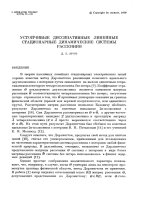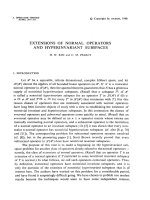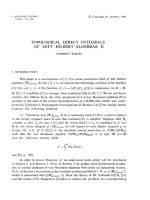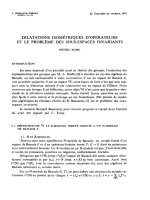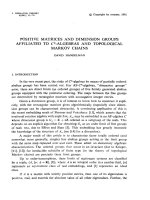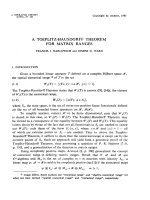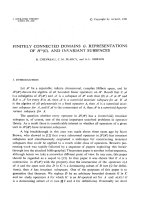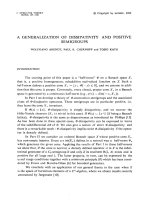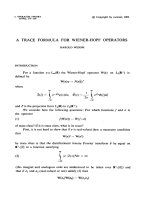Báo cáo toán học: "Low Rank Co-Diagonal Matrices and Ramsey Graphs" doc
Bạn đang xem bản rút gọn của tài liệu. Xem và tải ngay bản đầy đủ của tài liệu tại đây (129.22 KB, 7 trang )
Low Rank Co-Diagonal Matrices and Ramsey Graphs
Vince Grolmusz
Department of Computer Science
E¨otv¨os University, H-1053 Budapest
HUNGARY
E-mail:
Submitted: March 7, 2000. Accepted: March 12, 2000
Abstract
We examine n×n matrices over Z
m
, with 0’s in the diagonal and nonzeros elsewhere.
If m is a prime, then such matrices have large rank (i.e., n
1/(p−1)
− O(1) ). If m is
a non-prime-power integer, then we show that their rank can be much smaller. For
m = 6 we construct a matrix of rank exp(c
√
log n log log n). We also show, that explicit
constructions of such low rank matrices imply explicit constructions of Ramsey graphs.
Keywords: composite modulus, explicit Ramsey-graph constructions, matrices over rings,
co-diagonal matrices
1 Introduction
In this work we examine matrices over a ring R, such that the diagonal elements of the
matrix are all 0’s, but the elements off the diagonal are not zero (we shall call these matrices
co-diagonal over R). We define the rank of a matrix over a ring, and show that low rank co-
diagonal matrices over Z
6
naturally correspond to graphs with small homogenous vertex sets
(i.e., cliques and anti-cliques). Consequently, explicitly constructible low rank co-diagonal
matrices over Z
6
imply explicit Ramsey graph constructions. Our best construction repro-
duces the logarithmic order of magnitude of the Ramsey-graph of Frankl and Wilson [5],
continuing the sequence of results on new explicit Ramsey graph constructions of Alon [1]
and Grolmusz [6]. Our present result, analogously to the constructions of [6] and [1], can be
generalized to more than one color.
1
the electronic journal of combinatorics 7 (2000), #R15 2
Our results give a recipe for constructing explicit Ramsey graphs from explicit low rank
co-diagonal matrices over Z
6
, analogously to the way that our results gave a method for
constructing explicit Ramsey graphs from certain low degree polynomials over Z
6
in [6].
In this sense, our results may lead to improved Ramsey graph constructions, if lower rank
co-diagonal matrix constructions exist.
Definition 1 Let R be a ring and let n be a positive integer. We say, that n × n matrix
A = {a
ij
} is a co-diagonal matrix over R,ifa
ij
∈ R, i, j =1, 2, ,n and a
ii
=0,a
ij
=0,
for all i, j =1, 2, ,n, i = j.
We say, that A is an upper co-triangle matrix over R,ifa
ij
∈ R, i, j =1, 2, ,n
and a
ii
=0,a
ij
=0, for all 1 ≤ i<j≤ n. A is a lower co-triangle matrix over R,if
a
ij
∈ R, i, j =1, 2, ,n and a
ii
=0,a
ij
=0, for all 1 ≤ j<i≤ n. A matrix is co-triangle,
if it is either lower- or upper co-triangle.
We will also need the definition of the rank of a matrix with elements in a ring. The
following definition is a generalization of the matrix rank over fields to matrices over rings:
Definition 2 Let R be a ring and let n be a positive integer. We say, that n ×n matrix A
over R has rank 0 if all of the elements of A are 0. Otherwise, the rank over the ring R of
matrix A is the smallest r, such that A canbewrittenas
A = BC
over R, where B is an n ×r and C is an r × n matrix. The rank of A over R is denoted by
rank
R
(A).
It is easy to see, that this definition of the matrix rank coincides with the usual matrix-
rank over R,whenR is a field. The following property of the usual matrix rank also holds:
Lemma 3 Let R be a ring and let A and A
be two n × n matrices. Then rank
R
(A + A
) ≤
rank
R
(A)+rank
R
(A
).
Proof: Let A = BC and A
= B
C
,whereB is an n ×r and C is an r ×n matrix, while
B
is an n × r
and C
is an r
× n matrix. Then A + A
can be given as B
C
,whereB
is an n ×(r + r
) matrix, formed from the union of the columns of B and B
,andC
is an
(r + r
) ×n matrix, formed from the union of rows of C and C
.
The following theorem shows, that for any prime p, the co-triangle (and, consequently,
the co-diagonal) matrices over the p-element field have large rank:
Theorem 4 Let p be a prime, and let A be an n × n co-triangle matrix over GF
p
. Then
rank
GF
p
(A) ≥ n
1/(p−1)
− p.
the electronic journal of combinatorics 7 (2000), #R15 3
Proof: We may assume that A is a lower co-triangle matrix. Let r = rank
GF
p
(A), and
let B = {b
ij
} be an n × r, C = {c
ij
} be an r × n matrix over GF
p
, such that:
A = BC. (1)
For i =1, 2, ,n let us consider the following polynomials:
P
i
(x
1
,x
2
, ,x
r
)=
r
k=1
b
ik
x
j
. (2)
From (1),
P
i
(c
1j
,c
2j
, ,c
rj
)=
0, if i = j,
=0, if i>j.
Consequently, by the triangle criterion [2], polynomials
Q
i
(x
1
,x
2
, ,x
r
)=1− P
p−1
i
(x
1
,x
2
, ,x
r
),
for i =1, 2, ,n, form a linearly independent set in the vector space of dimension
r + p − 2
p − 1
+1
of polynomials of form Q + α,whereQ is an r-variable homogeneous polynomial of degree
p − 1andα ∈GF
p
. (To prove this without the triangle criterion of [2], one should observe
that Q
k
is zero on column i of matrix C for i<k, and it is 1 for column k of C;soQ
i
cannot
be given as a linear combination of some Q
k
j
’s, each k
j
>i.) Consequently,
n ≤
r + p − 2
p −1
+1≤ (r + p)
p−1
. (3).
We are interested in the following question:
Question. Let R = Z
m
, what is the minimum rank of an n ×n co-triangle (or co-diagonal)
matrix over R?
If m = p a prime, then by Theorem 4 we have that the rank should be at least n
1/p−1
−p.
What can we say for non-prime m’s?
The main motivation of this question is the following theorem:
Theorem 5 Let A = {a
ij
} be an n×n co-triangle matrix over R = Z
6
, with r = rank
Z
6
(A).
Then there exists an n-vertex graph G, containing neither a clique of size r +2 nor an
anti-clique of size
r +1
2
+2.
the electronic journal of combinatorics 7 (2000), #R15 4
Proof: Suppose, that A is a lower co-triangle matrix. If the Z
6
rank of A is r, then both
the GF
2
and GF
3
ranks of A are at most r.LetV = {v
1
,v
2
, ,v
n
}. For any i>j,letus
connect v
i
and v
j
with an edge, if a
ij
is odd. Then any clique of size t will correspond to a
t × t lower co-triangle minor over GF
2
, so from (3),
t ≤ r +1.
Any anti-clique of size t will correspond to a t ×t lower co-triangle minor over GF
3
,sofrom
(3),
t ≤
r +1
2
+1. (4)
From Theorem 5 one can get a lower bound for the rank, using estimations for the Ramsey
numbers. Our original bound was significantly improved by Noga Alon, who allowed us to
include his proof here.
Theorem 6 Let A = {a
ij
} be an n × n co-triangle matrix over R = Z
6
. Then
rank
Z
6
(A) ≥
log n
2 log log n
− 2.
Proof: By the result of Ramsey [7] and Erd˝os and Szekeres [4], every n-vertex graph has
either a clique on k, or an anti-clique on vertices, if
n ≥
k + − 2
k − 1
.
If we set k =
1
2
log n
log log n
,and = log
2
n, then we get from Theorem 5, that both r +2≤ k
and
r+1
2
+2≤ cannot be satisfied, and this completes the proof.
The proof of Theorem 5 also proves
Theorem 7 Suppose, that there exists an explicitly constructible n × n co-triangle matrix
A = {a
ij
} over R = Z
6
, with r = rank
Z
6
(A). Then one can explicitly construct an n-vertex
Ramsey-graph, without homogenous vertex-sets of size
r +1
2
+2.
Our main result is that there do exist explicitly constructible low-rank co-diagonal ma-
trices over Z
6
, implying explicit Ramsey-graph constructions.
the electronic journal of combinatorics 7 (2000), #R15 5
Theorem 8 There exists a c>0 such that for all positive integer n, there exists an explicitly
constructible n × n co-diagonal matrix A = {a
ij
} over R = Z
6
, with
rank
Z
6
(A) ≤ 2
c
√
log n log log n
.
Theorem 8 together with Theorem 5, gives an explicit Ramsey-graph construction on n
vertices, without a homogeneous vertex-set of size 2
c
√
log n log log n
, for some c
> 0, or in other
words, an explicit Ramsey-graph construction on
2
c
log
2
t
log log t
vertices, without homogeneous vertex-set of size t, for some c
> 0. This bound was
first proven by Frankl and Wilson [5] with a larger (better) constant than our c
,usingthe
famous Frankl-Wilson theorem [5]. We also gave a construction, using the BBR polynomial
[3] and also the Frankl-Wilson theorem in [6].
A generalization of our main result for ring Z
m
,wherem has more than two prime
divisors:
Theorem 9 For any m = p
α
1
1
p
α
2
2
p
α
, where the p
i
’s are distinct primes, there exists a
c = c
m
> 0 such that for all positive integer n, there exists an explicitly constructible n × n
co-diagonal matrix A = {a
ij
} over R = Z
m
, with
rank
Z
m
(A) ≤ 2
c
√
log n(log log n)
−1
.
2 Constructing Low Rank mod 6 Co-Diagonal Matri-
ces
In this section we prove Theorems 8 and 9.
Our main tool is the following theorem (choosing m = 6 and =2):
Theorem 10 (Barrington, Beigel, Rudich[3]) Given m = p
α
1
1
p
α
2
2
p
α
where the p
i
are
distinct primes, then there exists an explicitly constructible multi-linear polynomial P with
integer coefficients, with k variables, and of degree O(k
1/
) which satisfies for x ∈{0, 1}
k
,
that P (x)=0over Z
m
iff x =(0, 0, ,0).
Let k be the smallest integer such that n ≤ k
k
.LetB = {0, 1, 2, ,k−1}. Let us define
δ : B ×B →{0, 1} as follows:
δ(u, v)=
1, if u = v,
0otherwise.
the electronic journal of combinatorics 7 (2000), #R15 6
Then matrix
¯
A is defined as follows: both the rows and the columns of
¯
A correspond to the
elements of the set B
k
. The entry of matrix
¯
A in the intersection of a row, corresponding to
u =(u
1
,u
2
, ,u
k
) ∈ B
k
and of a column, corresponding to v =(v
1
,v
2
, ,v
k
) ∈ B
k
is the
number:
P (1 −δ(u
1
,v
1
), 1 −δ(u
2
,v
2
), ,1 −δ(u
k
,v
k
)). (5)
If u = v, then all of the δ(u
i
,v
i
)’s are 1, so the value of P is 0. So the diagonal of
¯
A is
all-0, but no other elements of the matrix are 0 over Z
6
,consequently,
¯
A is co-diagonal over
Z
6
.
Multi-linear polynomial P has degree O(
√
k), so (5) can be written as the sum of
k
≤ c
√
k
=
c
√
k
i=0
k
i
<k
c
√
k
(6)
monomials of the form:
a
i1,i2, ,is
δ(u
i1
,v
i1
)δ(u
i2
,v
i2
), δ(u
is
,v
is
), (7)
where c is positive, (in fact, c<3 is also satisfied), a
i1,i2, ,is
is an integer between 0 and 5,
and s ≤ c
√
k.
Since the (u, v) entry of
¯
A is the value (5), and (5) can be written as the sum of monomials
in (7), matrix
¯
A can be written as the sum of matrices D
i1,i2, ,is
, where the entry of matrix
D
i1,i2, ,is
in the intersection of a row, corresponding to u =(u
1
,u
2
, ,u
k
) ∈ B
k
and of a
column, corresponding to v =(v
1
,v
2
, ,v
k
) ∈ B
k
is equal to the value of (7).
It is easy to verify that D
i1,i2, ,is
can be written into the following form (applying the
same, suitable permutation to the rows and columns):
D
i1,i2, ,is
= a
i1,i2, ,is
11110000 0000
11110000 0000
11110000 0000
11110000 0000
00001111 0000
00001111 0000
00001111 0000
00001111 0000
.
.
.
.
.
.
.
.
.
.
.
.
.
.
.
.
.
.
.
.
.
.
.
.
.
.
.
.
.
.
.
.
.
.
.
.
.
.
.
00000000 1111
00000000 1111
00000000 1111
00000000 1111
the electronic journal of combinatorics 7 (2000), #R15 7
Let us observe, that the number of all-1 square minors, covering the diagonal is k
s
. Then,
from Lemma 3 the rank of D
i1,i2, ,is
is k
s
, s ≤ c
√
k. It follows from this and from (6), that
the rank of
¯
A is at most k
2c
√
k
.
Let matrix A be defined as the n × n upper left minor of matrix
¯
A. Obviously, A is also
a co-diagonal matrix, and its rank is at most k
2c
√
k
. Due to the choice of k the statement
follows.
The proof of Theorem 9 follows the same steps as the proof of Theorem 8. If m has
prime divisors, then polynomial P has degree O(k
1/
), so matrix D
i1,i2, ,is
has rank at
most k
s
, s ≤ ck
1/
, and co-diagonal matrix A has rank at most k
2ck
1/
, and this proves the
theorem.
Acknowledgment. The author is grateful to Noga Alon for his comments and for his
significant improvement of Theorem 6, and to Laci Babai for the discussions on this topic .
References
[1] N. Alon. The Shannon capacity of a union. Combinatorica, 18:301–310, 1998.
[2] L. Babai and P. Frankl. Linear algebra methods in combinatorics. Department of Com-
puter Science, The University of Chicago, September 1992. preliminary version.
[3] D. A. M. Barrington, R. Beigel, and S. Rudich. Representing Boolean functions as poly-
nomials modulo composite numbers. Comput. Complexity, 4:367–382, 1994. Appeared
also in Proc. 24th Ann. ACM Symp. Theor. Comput., 1992.
[4] P. Erd˝os and G. Szekeres. A combinatorial problem in geometry. Composition Math.,
2:464–470, 1935.
[5] P. Frankl and R. M. Wilson. Intersection theorems with geometric consequences. Com-
binatorica, 1(4):357–368, 1981.
[6] V. Grolmusz. Superpolynomial size set systems with restricted intersections mod 6 and
explicit Ramsey graphs. Combinatorica, 20:1–14, 2000. Conference version appeared in
Proc. COCOON’97, LNCS 1276.
[7] F. P. Ramsey. On a problem of formal logic. Proc. London Math. Soc., 30:264–286, 1930.
